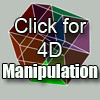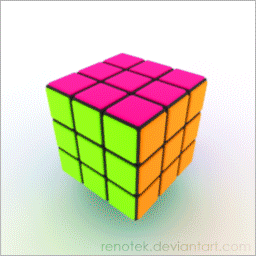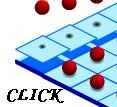HOME | DD
 DovSherman — Hypercube Manual Rotations
DovSherman — Hypercube Manual Rotations

#4d #hypercube #fourdimensional
Published: 2005-11-27 04:36:25 +0000 UTC; Views: 36671; Favourites: 214; Downloads: 1511
Redirect to original
Description
Someone requested a hypercube which could be manually rotated so I threw this together. Drag any of the sliders to rotate the hypercube around each of the six planes of rotation. You may notice that some rotations seem to have no effect when seem in orthographic or 3D perspective because the rotation is happening in directions which are not represented in those views when seen from some angles.A hypercube (or tesseract) is the 4-dimensional analogue of a cube. It has 16 corners, 36 edges, and 24 sides. All corners are right angles although they may seem like acute or obtuse angles when seem from a different viewpoint, just as the corners of a cube may seem sharper or wider depending on your viewpoint.
Rotation is achieved through a simple 4x4 transformation matrix which allows the hypercube to be rotated along a single plane at a time. In 3-dimensional rotation, rotation usually occurs around a linear axis but 4-dimensional rotation occurs around a planar axis.
You can check/uncheck the box to see the hypercube with solid sides or empty sides. Click on "Perspective" to select different methods of display.
Related content
Comments: 105

Despite what most people think, when it's taken to a certain level, math can be just as much of a cultural art form as music or painting. You just need to look at it from a different perspective.
Maybe you need to look at it from the W axis, as opposed to X, Y, or Z.
👍: 0 ⏩: 0

That's really nice simulation! Sometimes I've made a sketch of this cube, while I even din't know that it's exist
👍: 0 ⏩: 0

Hm, my dA search of "Tesseract" didn't end up fruitless after all. 
👍: 0 ⏩: 0

hmm and i thought that 4d was with time instead with... the things u said... but nice work!!
👍: 0 ⏩: 1

Time is a dimension but it's not as if they are locked in any particular order. We simply tend to refer to time as a fourth dimension because space has three dimensions. But hyperspace has four dimensions so, from that perspective, time would be a fifth dimension.
👍: 0 ⏩: 0

Shoot, amazing, and makes my head dizzy.
This is awesome, but I quite don't understand 4d
👍: 0 ⏩: 0

I'm getting a headache trying to wrap my mind around this. I think I'm trying too hard to actually visualize the tesseract.
👍: 0 ⏩: 0

This is incredibly awesome, and wonderfully done -- it's always great to have a visual reference. *plays with it some more....*
👍: 0 ⏩: 0

Dang, this is cool! Hpercubes are incredibly fun to explain to one's friends...
👍: 0 ⏩: 0

Thats nice 
👍: 0 ⏩: 0

Advanced Critique? I will be learning from you in this case. I have spent a lot of time considering the ramifications of higher dimensional existence, including two-dimensional time, and spatial dimensions to the order of over one hundred; however, I have NEVER encountered such a clear production of the concepts of a hypercube.
Perhaps after several hours of intense meditation of this work, I may begin to attain the grasp that you have. While a picture is worth a thousand words, this model is worth a million words.
I humbly prostrate myself before your greater gift.
👍: 0 ⏩: 1

It's actually fairly simple. If we're talking about simple geometric shapes, such as cubes, you can simply treat any number of dimenions as a series of numbers and then it's just a matter of applying basic matrix algebra to the shape. Of course, the more dimensions you use, the harder it is to see any difference since we're still limited to showing the 2-dimensional shadow of any object no matter how many or how few dimensions it possesses.
It's important to keep in mind that there's a great deal of difference between exploring dimensions from a purely mathematical viewpoint versus what it would be like to actually exist in a higher number of dimensions.
By the way, if you like dimensional exploration, I recommend A. K. Dewdney's exploration of a two-dimensional universe in his book "The Planiverse".
👍: 0 ⏩: 1

Thank you so much for your thoughtful reply.
Having read, "Flatland" and a sequel to it, "Sphereland", I do find it interesting that there is yet another book about the same subject. I will find that book that you recommend.
My initial reaction to your comment made me laugh; "...it's just a matter of applying basic matrix algebra..." Advanced mathematics, although I know that I would enjoy the subject, is not something that I have persued over the decades. I have kept to the easier road of quantum cosmology and psychology as it applies to the subconscious mind; they are light on math. Not that I avoid math; just as I have said, I haven't delved into it as much as I would like to have. (Now, that's some awful sentence construction; I better stop babbling.)
Again, thank you and I shall be stopping by again.
P.S. Your avatar is legally too cute.
👍: 0 ⏩: 1

Actually, they started teaching matrix algebra in schools long after I graduated high school so I had to pick up a high school textbook and teach it to myself but it's pretty easy once you get the basics. It just doing algebra where each variable can be a little grid of numbers instead of a single number.
👍: 0 ⏩: 1

I will have to add some mathematics study to my things-to-do list. Thanks for being encouraging.
👍: 0 ⏩: 0

aguhguh.
I think my brain just melted.
2D projection of a 3D image of a 4D object on a 2D screen.
O.O
👍: 0 ⏩: 0

I have readed of the ipercube into a comic, and I have readed something else: [link]
The one on the left is an opened cube, the one on the right is a opened ipercube.
👍: 0 ⏩: 1

The trick would be refolding that opened hypercube! You'd have to fold it in directions that don't exist in a three-dimensional world.
👍: 0 ⏩: 1

Man! Just think the applications that could be done in 3D videogames, with stuff like this!
👍: 0 ⏩: 0

... Please do not think ill of me when all I can muster to say is "whoa".
👍: 0 ⏩: 0

I know I'm a bit late with this comment, but I just have to say- this is one of the best representations of an interactive hypercube that I've yet seen. I don't know why I didn't fav this sooner!
👍: 0 ⏩: 0

A hypercube (or tesseract) is the 4-dimensional analogue of a cube. It has 16 corners, 36 edges, and 24 sides. All corners are right angles although they may seem like acute or obtuse angles when seem from a different viewpoint, just as the corners of a cube may seem sharper or wider depending on your viewpoint.
Rotation is achieved through a simple 4x4 transformation matrix which allows the hypercube to be rotated along a single plane at a time. In 3-dimensional rotation, rotation usually occurs around a linear axis but 4-dimensional rotation occurs around a planar axis.
Yer wot? And I thought I was smart!
👍: 0 ⏩: 0

nice.
i worked out the 4D rotation matrices once too, it was pretty fun stuff.
👍: 0 ⏩: 0

Tesseracts make my head hurt so much... probably because they're trying to represent a 4D object in 3D space on a 2D screen.
👍: 0 ⏩: 1

Actually, it's the *shadow* of a 4D object. When we draw a 3D object, like a cube, on a 2D piece of paper, we're not really drawing a 3D cube, we're drawing the 2D shadow of that cube. That's photography works too - an image created by exposing light-sensitive material to the 2D shadow of the something in our 3D world.
The trick to working with 4D (or 5D or 100D) is to simply accept that anything above 3D is impossible to fully visualize in a human brain and just think of the extra dimensions as a list of numbers.
👍: 0 ⏩: 3

OH I THINK I GET IT. The 

The 

I still don't get why the Escher effect of the W sliders making "surfaces" go back or forth as if it was a perspective trick.
I swear I'm not one of those people who collect doorknobs.
👍: 0 ⏩: 1

One of the trickier things to understand about 4D rotation is what you are rotating around. On a 2D surface, you rotate around a 0D object, a point. In 3D space, you rotate around a 1D object, a line. In 4D hyperspace, you rotate around a 2D object, a plane. But since we are wired for 3D, it's hard to visualize what rotating around a plane would mean.
👍: 0 ⏩: 1

The way I imagine it, rotation around a plane could be alot like rolling... Which is probably why rotating 4D objects such as a pentachoron or tesseract seem to go in and out themselves.
Am I correct? Or is the "in-out" effect just perspective?
👍: 0 ⏩: 1

Hard to say. I have always imagined 4D rotation to be kind of like that little toroidal water balloon toys that are like a tube that endlessly tries to squirt out of your grasp.
👍: 0 ⏩: 0

Sorry to butt in, but isn't it like trying to represent a cube in a 1D line? I think it would be easier to have a manipulateable 3D shadow of one of these buggers. How did you PROGRAM this, anyway? It's amazing how flash even knew what you were on about when you put in the W coordinate, when you can't visualize it yourself (I assume).
I am absolutely fascinated by this piece and I would totally DD it if I could. Me and my bf are playing aroun with it trying to *see* it
Quick question - Why is it that when I use the X,Z and Y sliders it behaves like a cube-within-a-cube, but when I use only the W slider it goes back to behave like just one cube? Or, well, two cubes almost the same size actually. It's like Escher designed this thing - the surface that is the furthest becomes the nearest.
Furthermore, if I place it at an angle in the X, Z or Y axis, just enough for it to be obvious that there is a smaller cube inside the big one, and then use the W axis, the whole thing just starts going in and out itself! Why can't it just go back to behave like two similar-sized cubes? IT'S SELF AWARE. jkjk.
I read that our Universe is a 4-sphere, shouldn't that mean that the stuff inside it (eg. us) would see the effects of living with an extra dimension? Are we merely on the 3D "surface" of the 4-sphere?
(just asking this because I'm really bitter that I don't get to see a real tesseract. pout.)
👍: 0 ⏩: 1

It is a lot like trying to draw a shadow on a 1D line. However, this is really the most you can do to represent 4D without some kind of holographic tank. Of course, if you did have a holographic tank, you'd just be showing the 3D shadow cast by the 4D object.
Flash doesn't have any built-in 4D support. I do the calculations in code and then just tell it the screen coordinates for the points and lines.
Yes, I think the theory of our universe being a hypersphere means that what we think of as space is the surface of that hypersphere, kind of like if we lived in the line of a 1D universe which was actually a circle.
👍: 0 ⏩: 0

If it's a shadow it means in a real 3D world we could pass through it like an hologram, while just changing color in the process, right?
👍: 0 ⏩: 1
| Next =>








































